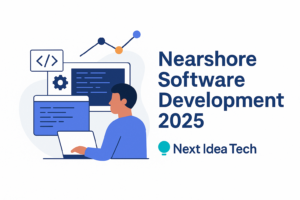
The Information Technology (IT) industry is at the forefront of driving digital innovation, transforming how we live, work, and do business. As businesses adapt to this digital revolution, there has been an exponential demand for nearshore IT staff augmentation services. Experts estimated that in 2022 the US IT and temporary staffing market was worth over USD 41 billion. The dramatic use of contingent workers within the IT industry is fueled by varying workloads, changing project specifications, emerging trends such as artificial intelligence, cloud computing, and edge computing which demand specialized skills.
Hire the best developers in Latin America. Get a free quote today!
Contact Us Today!Adapting to these ongoing changes becomes difficult when you’ve made long-term commitments to hire in-house staff because not many businesses in the software development industry have static needs that never change. Scaling your team internally as a strategy to meet any urgent skill requirements can be both expensive and risky.
But what is the alternative when you need to keep up with the latest innovations and stay competitive within your industry?
That’s where IT staff augmentation comes in, enabling software development companies to meet any technical capabilities outside of their core skill set by adding specialized staff to their teams on demand. Although initially conceived in the early 90s as part of the broader Business Process Outsourcing model (BPO), the IT staff augmentation market has exploded. When considered in light of moves from industry giants like Google—where 50% of the workforce comprises of temps, vendors, and contractors, or “TVCs”—the importance of augmented staff for enterprises, now and in the future, cannot be overstated.
But before bringing in external talent to run parts of your enterprise, it is worth pausing to consider how IT staff augmentation works and why you should give it some thought. Use this guide to examine these questions as well as the advantages and best practices of this innovative strategy.
What is IT Staff Augmentation?
IT staff augmentation is a type of business process outsourcing model that leverages external workers to fill short-term job positions. This strategic approach involves inquiring into the existing skills of your in-house team, determining the additional skills required for successful business delivery, and then collaborating with external IT professionals who are suitable for short-term project support, often through a service provider. By using staff augmentation, you can grow your teams, capabilities, and the number of resources that you have without actually having to legally employ technical talent and incur the costs of hiring full-time staff.
How Does IT Staff Augmentation Work?
In the IT staff augmentation hiring model, software engineers are usually hired through a third-party agency. Businesses in need of temporary software developers will contact the agency and offer a description of the type of developer required. The agency will then research its database of potential engineers and put forward the best candidates. Therefore, it is of great importance that businesses give their preferred agencies a detailed description of which skills and experience are required. Once suitable candidates have been selected, they will be contracted between the business and the agency for a predetermined time and at a certain rate.
IT staff augmentation has become increasingly popular with software development businesses because of the high staff turnover in comparison to other industries.
Next Idea Tech, a leading B2B IT staff augmentation service provider, is a prime example of an entity specializing in connecting organizations with top-tier IT professionals. We serve as a bridge between businesses and highly skilled IT experts, making it easy to ramp your team up or down based on evolving project needs.
Difference Between IT Staff Augmentation & IT Outsourcing
Staff augmentation differs from the traditional outsourcing model in control and involvement. With outsourcing, the vendor is fully responsible for the day-to-day management and performance of the staff. The business could rest easy and expect full delivery of outcomes from the vendor. The drawback, however, is that this model requires more autonomy over the work.
Whereas with staff augmentation, your business has more control and involvement over the contracting, management, and output of the developers working directly with the existing team. Another key difference is the level of commitment required. Outsourcing typically engages in long-term contracts, with the promise of continued growth and efficiency gains, while staff augmentation can be on a project basis with less commitment.
| IT Staff Augmentation | IT Outsourcing |
| Purchasing engineering resources while maintaining direct control over your team. | Paying for a specific, prearranged outcome, and sharing the burden of risk with the outsourcing vendor. |
| Flexible and scalable for rapid-growth projects. | Stable and reliable for long-term IT management. |
When is Staff Augmentation a Suitable Approach?
Let’s now look at some common scenarios when IT Staff Augmentation can help you reduce the challenges of growing your team internally.
Scenario 1:
When a business takes on a new project but lacks the staffing capacity or resources to train new employees to complete the project in the timeframe required.
For example, imagine having a project with a tight two-month deadline. Traditional hiring processes could take over a month, jeopardizing your project’s success. This is where IT staff augmentation shines. By partnering with an IT staff augmentation firm, you can secure top talent in a matter of days, or even hours, without the hassle of screening, negotiations, or onboarding. This approach ensures your project runs efficiently and delivers quality results.
Scenario 2:
When an employee leaves a company in the pursuit of a new opportunity or even just for their annual leave.
For example, when one of your key team members is indisposed because of the aforementioned reasons and suddenly, there’s a gap in your workforce, slowing down your whole team’s workflow. This is a common challenge many businesses face and this is precisely the type of scenario where engaging with an IT staff augmentation firm can come in handy. Instead of facing productivity dips and project delays, you can swiftly fill the gap by bringing in skilled IT professionals through augmentation for you to manage as a client. These temporary team members seamlessly integrate with your existing dev teams, ensuring that the workflow is uninterrupted, and your projects stay on track.
Scenario 3:
When a business is looking for the best permanent team to hire, staff augmentation can serve as a bridge between businesses and highly skilled IT experts. You can engage an IT staff augmentation firm to hire and train co-located teams of developers for you to manage as a client. This makes it easy to scale up or down based on project needs and ensures business continuity.
These scenarios are just a few examples highlighting instances where IT staff augmentation can be an effective hiring solution for businesses. However, there are many other scenarios where businesses can also benefit from augmenting their tech talent with the major reason being due to limited access to resources.
What are the Benefits of Staff Augmentation?
IT staff augmentation is increasingly becoming one of the most sought-after recruitment models because it offers so many benefits to businesses; starting with:
- Staffing Flexibility: Perhaps the biggest advantage that you get from IT staff augmentation is a skilled resource on demand. Your organization can quickly respond to changing demands, scaling the workforce up or down as required to fulfill a temporary spike in everyday work, much in the same way that retail stores contract seasonal employees. It can also be used if a project requires a short-term solution or the timeline is too tight. The flexibility of hiring based on needs, without having to go through an internal hiring process, is invaluable for project-based work.
- Reduced Overhead Costs: IT staff augmentation can be a more cost-effective solution compared to hiring full-time employees. Hiring full-time engineers brings various expenses like office space, IT equipment, training, operational costs, payroll taxes, health insurance, office perks, and other fringe benefits, while independent nearshore IT professionals do not require the same benefits, eliminating these expenses. Hiring full-time developers also takes valuable time, effort, and money out of businesses. IT staff augmentation reduces these liabilities by using skilled and vetted yet cost-effective nearshore developers who don’t compromise work quality. You pay for the skills you need only when you need them, reducing long-term financial commitments.
- Access Specialized Skills: IT staff augmentation allows you to tap into niche expertise that may not be readily available within your in-house team, or that may only be attainable via significant training and experience (new stack, cloud setup, etc.), giving you a competitive edge. Your business can pull in specific skill sets on a per-project basis, rather than having to hire new employees. For example, maybe your company wants to create an AWS micro-service architecture and doesn’t have any engineers with any experience in that. You might bring in consultants with that experience who can help design the system and show their engineers how things should be done.
- Reduced Recruitment Hassles: Partnering with an IT staffing service provider streamlines the hiring process, saving time and resources while ensuring you access a broad pool of top talent. On another level, IT staff augmentation can be used as a “trial run” for potential full-time developers; the staffing organization takes a hit in the case of a mis-hire, rather than the organization.
- Reduced Training and Onboarding Time: Hiring remote nearshore software developers who are already trained and experienced reduces recruitment, training, and onboarding costs compared to bringing in permanent employees.
- Faster Time-to-Market: Augmenting your team with experts can help you ramp up capacity quickly – enabling you to meet deadlines and deliver results faster.
Types of IT Staff Augmentation
There are five IT staff augmentation models that your business can adopt to extend the existing capacity. Let’s delve into these models in more detail.
1. Full-time Equivalent (FTE)
The FTE staff augmentation model involves hiring a full-time software developer in the interim to work on-site. This is ideal in scenarios where you need a dedicated team member to work on-premises on a specific project or a set of tasks for an extended period.
2. Project-based
The project-based IT staff augmentation model entails hiring a consultant to work on a particular project or a set of tasks. It’s ideal in instances where you need specialized skills for a short period.
3. Remote
The remote IT staff augmentation model is best for engaging onshore, nearshore, or offshore software developers working remotely. It’s ideal for businesses that want to tap into a global workforce to ramp up capacity.
4. Managed Services
This model involves delegating the staffing and management of a specific department or business unit to a third-party IT staff augmentation services provider. It allows your business to focus on its core competencies as the managed service provider takes care of other business functions on your behalf.
5. Hybrid
The hybrid IT staff augmentation model combines any mix of FTEs, contractors, remote developers, and managed service providers to acquire the requisite expertise as needed.
| MODEL | PROS | CONS |
| Full-time Equivalent (FTE) | Dedicated Employee On-site Presence Long-term commitment | Costly It takes time to fire and on-board Difficult to terminate |
| Project-based | Access to specialized skills Cost-effective Ease of transaction | Limited work hours Limited control of work quality Lack of continuity |
| Remote | Access to global talent Cost-effective Efficient | Communication challenges Limited interaction Limited monitoring |
| Managed Services | Access to expertise Speed in building a team Enhanced business focus | Costly Limited management Limited control of outcomes |
| Hybrid | Access to a wider talent pool Flexible Scalable | Costly Complex Risky |
Best Practices for Successful IT Staff Augmentation
Below, we’ve compiled the top 8 staff augmentation best practices for IT and software development projects so that you can recruit exceptional talent and get the most out of your collaborations with them.
1. Define Clear Job Roles and Expectations
When selecting and onboarding augmented software developers into your team, start by identifying the gaps in the knowledge and skills of your existing dev team. This clarity will help you address all critical expertise gaps that need to be addressed for the successful completion of your software development project.
Next, outline the project’s goals and objectives, and your expectations of the software engineers you’re looking to hire. It can be highly beneficial to identify project timelines as well as specific tasks, deadlines, and outcomes. If you are struggling with this or have limited time to dedicate to it, you can delegate this to a dedicated project manager who oversees the progression of the project and helps you with the hiring and onboarding of your new nearshore software developers.
2. Maintain Open, Transparent Communication with Augmented Staff Members
Communication is one of the top challenges when working with augmented staff. Nonetheless, it’s critical to productivity, can improve project outcomes, and help your team meet deadlines.
According to a McKinsey report, well-connected teams are, on average, 20-25% more productive. This also extends to hybrid and remote teams.
In addition to communicating via communication platforms like Slack, it’s within staff augmentation best practices to have regular face-to-face communication via video conferencing apps such as Zoom or Microsoft Teams to build relationships and address issues in real-time.
3. Leverage Project Management Tools
In many software development projects, resources, and management resources are often allocated to a project manager. This is done to optimize project timelines, adherence to budgets, as well as the level of productivity and quality of work.
One of the reasons why project management is so effective is the use of project and communication tools, much so as you rely on augmented staff.
Project management tools like Asana, Jira, Trello, and monday.com can help your team track the progress. Therefore, as you on-board new team members, they can see exactly what is expected of them and what the deadlines are.
4. Provide Digital Documentation of Your Project Processes
Provide new hires with all relevant documents detailing all the processes and procedures for remote work at your company in a digital format. This can include training manuals, samples, videos, reports, or other forms of documentation that are relevant to your project. The new hires must gain access to all the information they need to adequately complete their job. Ideally, you should have an online portal or use cloud storage for easy access to these documents. To learn more about to furnish new hires with this information, check out our blog post on how to successfully on-board new hires.
5. Stay Involved Throughout the Project Execution Process
In the IT staff augmentation model, external professionals usually have a significant responsibility to ensure the success of your software development project.
Therefore, it’s a best practice to track the performance and efficiency of your external professionals. You should establish a schedule for regular check-ins so that people are posting their quantitative goals (KPIs they’ve been focused on hitting) and more importantly they communicate any blockers so that they can be addressed and resolved swiftly. Encourage open communication and make sure new hires feel comfortable reaching out for help.
If you do not have the time or capacity for such involvement, you can always delegate this responsibility to a project manager.
6. Have Non-Disclosure Agreements (NDA) in Place
The software development market is fiercely competitive, and your external staff will be working on other development projects. Therefore, including confidentiality clauses in the contract with your IT staff augmentation provider can offer your business an extra layer of protection and prevent confidential information, trade secrets, and intellectual property from getting into the wrong hands.
7. Select a Reliable and Reputable IT Staff Augmentation Service Provider
Last but not least, you need to choose a trusted staff augmentation provider as the outsourcing market is becoming increasingly more saturated, and bad apples are
more common. Below are some of the best practices for vetting staff augmentation vendors:
- Select a staff augmentation provider with a wide network of talent, various recruiters, and a low attrition rate. Attrition refers to the process of the company losing its employees due to a broad range of reasons, and it should optimally be no higher than 10-15%. This will ensure that your provider will always have tech talent available.
- Examine reviews from previous clients: Take into consideration their experiences, whether they were satisfied with the choice of professionals, and recruiting speed. How successful were project outcomes? What issues or challenges did they experience, and did the vendor address them?
- Evaluate their work culture—and ensure it matches yours. Schedule introductory calls to determine their values, culture, and terms of collaboration. Ask yourself: Do their values and working style align with yours? What sets them apart? Are they open and transparent? Can you trust them? This will help you determine whether you are comfortable communicating and working with them.
Key Takeaways
IT staff augmentation is a powerful model that organizations can leverage to increase agility and respond to the changing project needs, regardless of the particular talents you want, such as project managers, IT specialists, or other specialists. Adopting this cutting-edge strategy and following the best practices outlined in this post can help you maximize the benefits of IT staff augmentation ensuring the overall success of your IT projects. By working with a reputable service provider, you can successfully traverse the IT staff augmentation landscape and enable your company to prosper in today’s competitive business landscape.
Next Idea Tech, a leading B2B IT staff augmentation service provider, is a prime example of an entity specializing in connecting organizations with top-tier IT professionals. We serve as a bridge between businesses and highly skilled IT experts, making it easy to scale up or down based on project needs.
If you’re looking to augment your existing team with nearshore developers or are looking for a dedicated team of nearshore developers, Next Idea Tech can help. We source, hire, and pay software developers in Latin America who speak fluent English and work around your time zone.
Thanks to our large database of pre-vetted developers in Latin and Central America, we have direct access to resources with different disciplines and technical skills working in your time zone. There’s no risk.
For more information, visit Next Idea Tech’s Hire Page.




